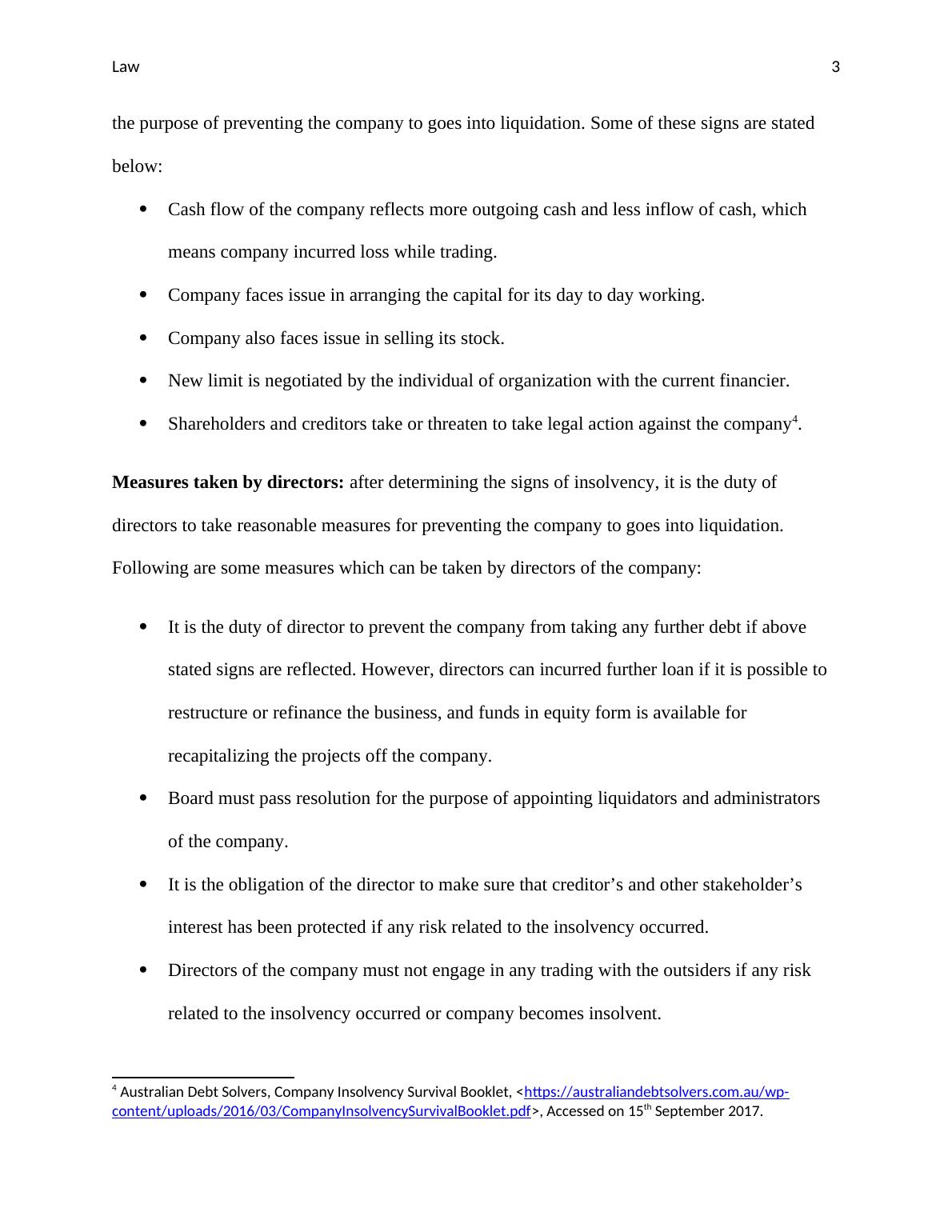Essay on Insolvency in Law
Added on 2019-11-19
11 Pages2330 Words279 Views
Running Head: Law 1Law

Law2Introduction:Insolvency is that state when company’s total liabilities exceed its total assets. Section 95 A1 of the Corporation Act 2001 states, any organization or individual can be considered as solvent if such organization or individual is able to pay all the debts and liabilities when they become due and payable. This section further states, individual or organization is considered as insolvent if they are not solvent. In this essay, various terms related to insolvency are discussed such director’s role, ASIC role, various methods of insolvency, and process of insolvency. This essay also defines the statistics related to insolvency and observance. Lastly, brief conclusion is stated for concluding the paper2.Meaning of insolvency & signs related to insolvency: Insolvency is defined under section 95A of the Act, and it is considered as that situation when it becomes impossible for organization or individual to pay its debts. In other words, organization or individual does not have that much assets which can be used to pay the debts of the company. Court determines primary method for the purpose of determining the company’s solvency in caseBell Group Ltd (in liquidation) v Westpac Banking Corporation & Others3. In this case, court held that solvency of company can be determined through the assets and liabilities of the company. Signs related to insolvency: There are number of signs which reflect the actual position of the company such as profitability, goodwill, growth reflect the solvent position of the company. In similar way unprofitability and excess debts reflect the insolvent position of the company. It is necessary for directors of the company to determine the signs of insolvency at former stage for 1 Corporation Act 2001- Section 95A.2 ASIC. Types of Insolvency. < http://asic.gov.au/regulatory-resources/insolvency/types-of-insolvency/>, Accessed on 15th September 20173 Bell Group Ltd (in liquidation) v Westpac Banking Corporation & Others.

Law3the purpose of preventing the company to goes into liquidation. Some of these signs are stated below:Cash flow of the company reflects more outgoing cash and less inflow of cash, which means company incurred loss while trading. Company faces issue in arranging the capital for its day to day working.Company also faces issue in selling its stock.New limit is negotiated by the individual of organization with the current financier.Shareholders and creditors take or threaten to take legal action against the company4. Measures taken by directors: after determining the signs of insolvency, it is the duty of directors to take reasonable measures for preventing the company to goes into liquidation. Following are some measures which can be taken by directors of the company:It is the duty of director to prevent the company from taking any further debt if above stated signs are reflected. However, directors can incurred further loan if it is possible to restructure or refinance the business, and funds in equity form is available for recapitalizing the projects off the company. Board must pass resolution for the purpose of appointing liquidators and administrators of the company. It is the obligation of the director to make sure that creditor’s and other stakeholder’s interest has been protected if any risk related to the insolvency occurred. Directors of the company must not engage in any trading with the outsiders if any risk related to the insolvency occurred or company becomes insolvent.4 Australian Debt Solvers, Company Insolvency Survival Booklet, <https://australiandebtsolvers.com.au/wp-content/uploads/2016/03/CompanyInsolvencySurvivalBooklet.pdf>, Accessed on 15th September 2017.

Law4Liabilities of directors in insolvency: Corporation Act imposed number of responsibilities on directors of the company if any risk related to insolvency occurred or company becomes insolvent. Section 588G of the Act imposedthis liability. According to Section 588G of the Act, it is the duty of the director to restrict the trading at the time of insolvency5.Applicability of section 588G- this section is applicable not only on the directors of the company but o those individuals also who were not appointed as company’s director but they were acting as the directors of the company. This section further state, obligation of director arises in following situations:Organization becomes insolvent at that time when debt is incurred.Risk related to insolvency occurred if organization decided to take debt Such reasons are present which make the director’s believe that company face risk ofinsolvency or becomes insolvent if such debt is incurred by the company. In case Kenna& Brown Pty Ltd v Kenna6, Court stated that directors must conduct objectiveassessment for the purpose of determining the insolvency.Contravention of section 588G- there are two types of contravention related to this section, andthese contraventions are stated below:If directors of the company fail to prevent the company from incurring further debt, eventhough sufficient reasons are present which make the directors believe that risk related toinsolvency is present or company becomes insolvent, then such failure can be considered5 Corporation Act 2001- Section 588G. 6 Kenna & Brown Pty Ltd v Kenna.

End of preview
Want to access all the pages? Upload your documents or become a member.
Related Documents
Paper on Company’s Insolvencylg...
|11
|2500
|115
Assignment Of LAW | Insolvency Consideration - LG237lg...
|11
|2559
|90
Commercial and Corporation Lawlg...
|12
|4002
|320
Corporate Law Instructors Name Institution Supervisors Name Course Introductionlg...
|23
|3263
|116
CLAW314 Corporate Law - Insolvency of a companylg...
|7
|2697
|207
Corporations Law: Duties of Directors and Powers of Liquidatorlg...
|5
|1057
|440
